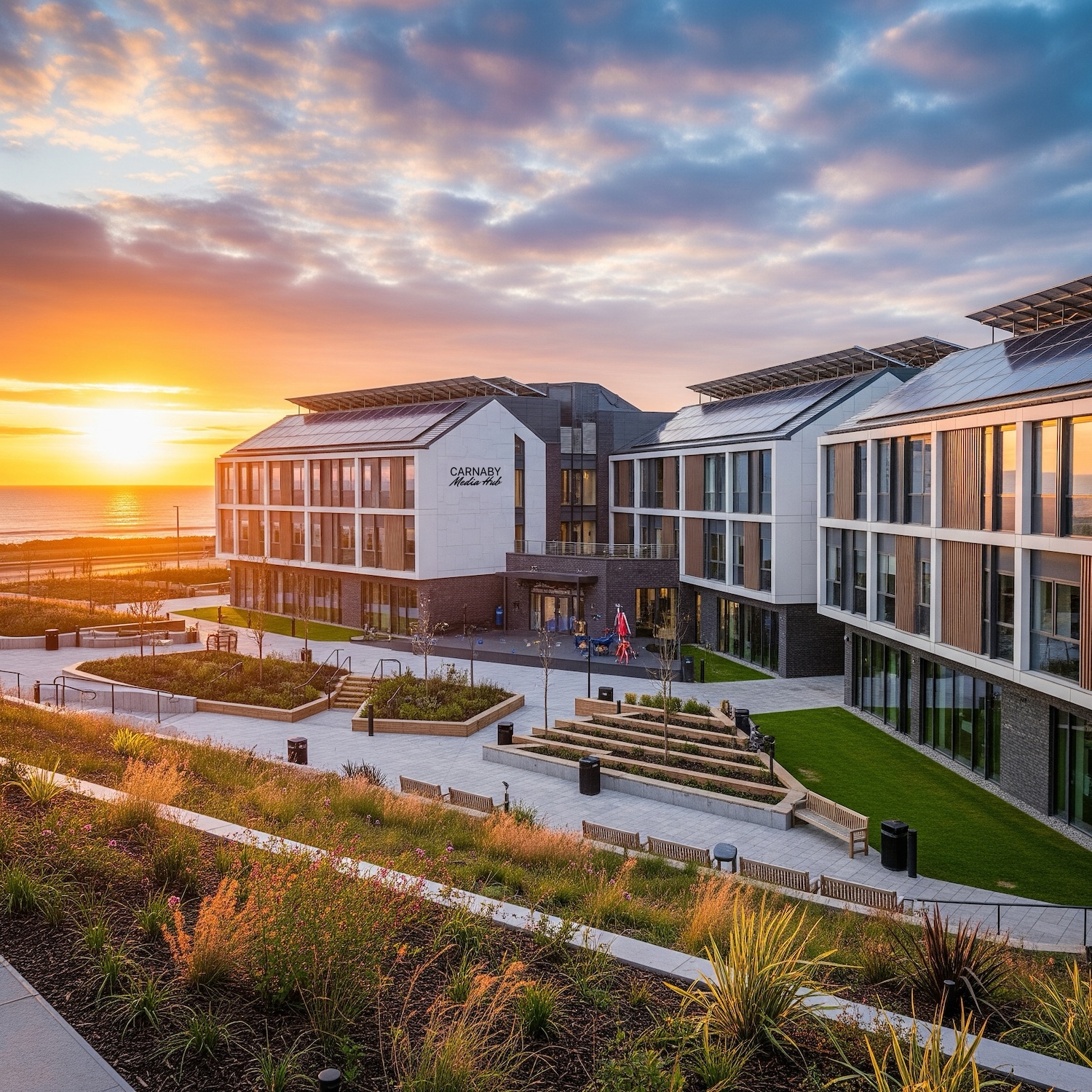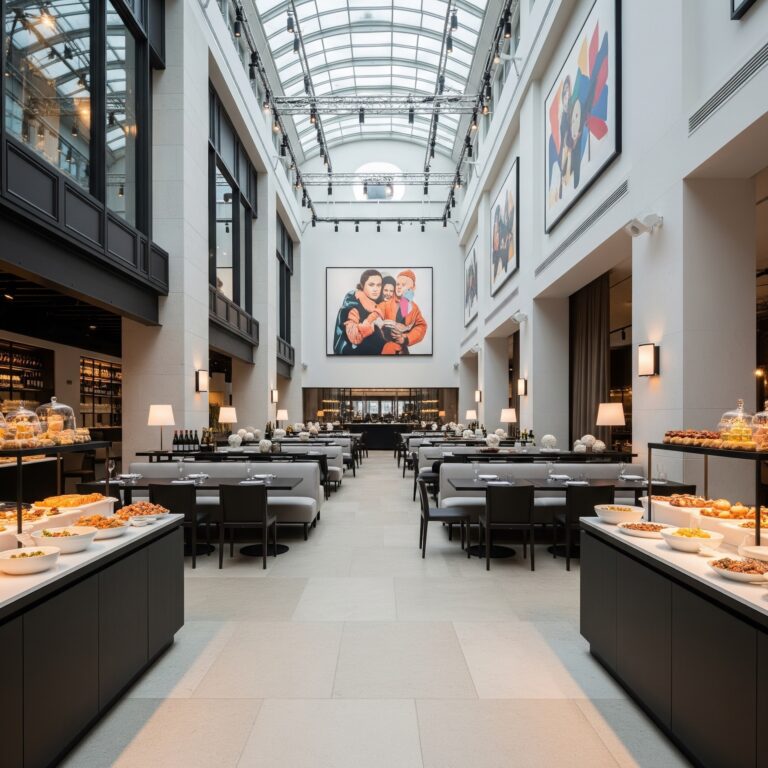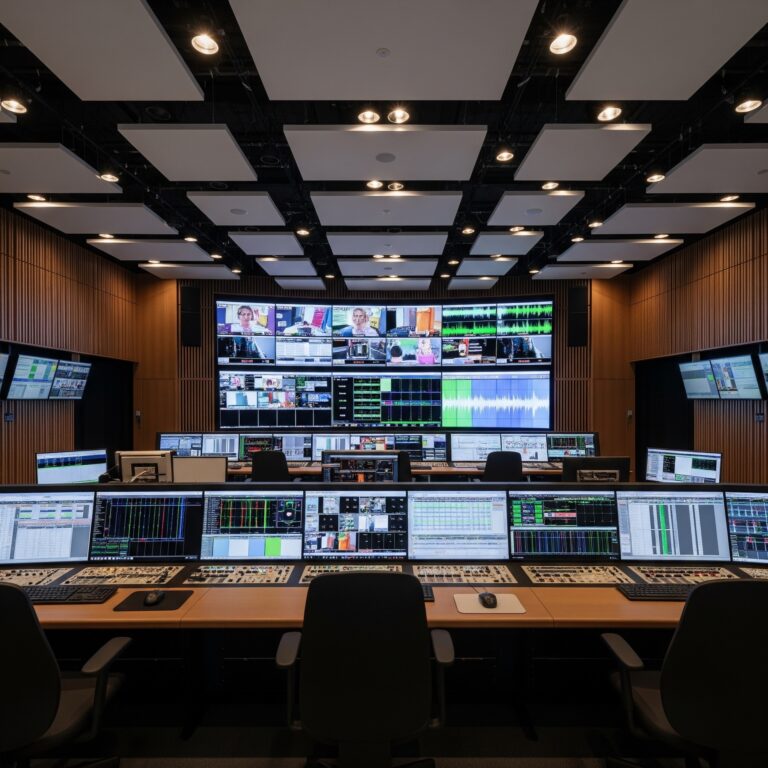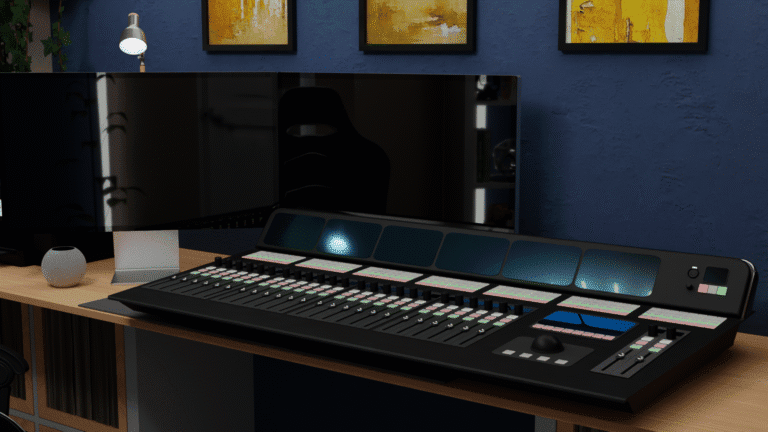It’s Not Easy Being Green
Introduction: The Green Canvas of Creativity
Every frame rendered, every note recorded, every broadcast launched from the Carnaby Media Hub is powered not just by innovation, but by a profound commitment to environmental stewardship. In an industry often characterized by high energy demands and rapid technological cycles, CMH aims to redefine what it means to build and operate a media powerhouse responsibly. We believe that true leadership in the 21st century extends beyond delivering breathtaking content; it encompasses the very foundation upon which that content is created.
This post pulls back the curtain on the unseen foundations of CMH, revealing the vital physical infrastructure that quietly ensures every operation runs perfectly, day in and day out. But more than that, it showcases our pioneering sustainable practices. From generating our own clean energy and meticulously managing resources to integrating our facility thoughtfully into its coastal surroundings in Bridlington, we’re building a future where cutting-edge technology and ecological responsibility don’t just coexist, but thrive together. We’ll explore our proactive initiatives, transparently discuss the inherent challenges that come with pushing the boundaries of high-tech production, and ultimately demonstrate how CMH is designing a blueprint for a greener, more conscious media future.
The Unseen Backbone: Physical Infrastructure Designed for Efficiency & Resilience
While we’ve spent a good deal of time marveling at CMH’s digital arteries – those lightning-fast IP networks, the control room brains, and the dazzling virtual stages – none of that dazzling tech would even flicker without a colossal, yet often unseen, physical foundation. Think of it as the superhero’s perfectly tailored, super-strong suit, quietly enabling all the flashy heroics. This section isn’t about the glamorous cameras or the sleek consoles; it’s about the very air you breathe, the power that hums, and the hidden pathways that crisscross the building, all meticulously engineered with sustainability in mind.
First up, let’s talk about power supply and distribution. In a facility where a momentary flicker could derail a live global broadcast (or worse, wipe a render farm – shudder!), redundancy is key. So, yes, CMH would feature multiple layers of protection: massive Uninterruptible Power Supplies (UPS) acting as digital shock absorbers for brief outages, and roaring automatic backup generators ready to kick in if the grid decides to take an extended holiday. But beyond mere resilience, our electrical systems are designed for maximum efficiency. We’re talking about Intelligent Power Management Systems (IPMS) that are smarter than your average energy meter, dynamically monitoring and allocating power only where and when it’s needed. No more phantom loads or energy wasted on idle equipment; if a studio is dark, its non-essential systems are powered down, ensuring every kilowatt-hour is a truly productive one. This isn’t just about being green; it’s about pure, unadulterated operational intelligence.
Next, consider the lifeblood of any tech-heavy facility: HVAC and precision climate control. Keeping acres of sensitive electronics cool and comfortable without sounding like a jet engine is an art form. CMH would employ state-of-the-art Heating, Ventilation, and Air Conditioning systems that are high-efficiency, utilizing advanced refrigerants and variable speed drives to precisely manage temperature and humidity. Crucially, we’d integrate Heat Recovery Ventilation (HRV) or Energy Recovery Ventilation (ERV) systems. This clever tech captures the warmth (or coolness) from outgoing exhaust air – perhaps from those hard-working server rooms or bustling studios – and uses it to pre-condition incoming fresh air. It’s like having your HVAC system recycle its own breath, drastically cutting down on heating and cooling loads. And because a perfectly clean audio recording means zero background hum, our HVAC systems are meticulously designed with acoustic isolation, ensuring sound integrity isn’t compromised by whirring fans or clanking ducts.
Then there’s the very skin of the building: its high-performance envelope and advanced insulation. This is where architecture truly meets ecology. The entire structure of CMH would be wrapped in superior, high R-value insulation in walls, roofs, and even floors, acting like a giant, perfectly sealed thermos to reduce energy transfer. We’d utilize high-performance Low-Emissivity (Low-E) glazing for our windows, allowing abundant natural light to flood in without the downsides of excessive heat gain or loss. And we’d obsess over eliminating “thermal bridging” – those tiny pathways in a building’s structure where heat can sneak in or out. If we were feeling particularly ambitious in our theoretical budget, a living “green roof” or vertical gardens could even contribute to insulation, stormwater management, and local biodiversity – because even the exterior can do its bit!
Beneath the sleek surfaces, out of sight but never out of mind, lies the vast network of smart cabling and conduit systems. Forget spaghetti junction; imagine miles upon miles of meticulously organized physical cabling for power, video, audio, and control, all routed through dedicated, accessible conduits. This isn’t just neatness for neatness’ sake. Intelligent routing reduces unnecessary cable length and signal loss, which surprisingly contributes to overall system efficiency. It also means that when a new piece of kit needs hooking up, or an upgrade is due, our engineers aren’t playing a game of “Where’s Wally” with wires; they’re working with a clear, flexible system.
Finally, while primarily for security, our integrated physical security and automation systems also play a quiet role in efficiency. Centralized access control ensures that sensitive areas are only powered up when in use, and smart lighting/HVAC integration turns off systems automatically in unoccupied zones. It’s about minimizing waste across the board, even in the unseen corners.
This comprehensive physical infrastructure, while costing a pretty penny in our theoretical budget, forms the unwavering, ecologically-minded foundation upon which all of CMH’s creative and broadcast ambitions confidently stand. It’s the silent giant working tirelessly to keep the lights on, the sounds pristine, and the planet a little bit happier.
Green Energy Innovation: Powering CMH Responsibly
Now, this is where our “theoretical, very expensive” project starts to make a truly impactful statement. In an industry notorious for its energy demands, the Carnaby Media Hub doesn’t just consume power; it aims to generate it, and what it doesn’t generate, it procures with a meticulously clean conscience. This section isn’t just about efficiency (though we love that too); it’s about pioneering Green Energy Innovation that powers CMH responsibly, striving for self-sufficiency and a significantly reduced carbon footprint.
First and foremost, let’s talk about on-site renewable energy generation. Imagine, if you will, the vast, expansive rooftops of the Carnaby Media Hub – not just for satellite dishes (though those might have their place for distribution!), but gleaming with extensive Solar PV Arrays. These photovoltaic panels would be more than just a token gesture; they’d be a substantial power source, feeding directly into CMH’s sophisticated internal power grid. And because the sun isn’t always obliging (especially in, ahem, certain parts of the UK), these arrays would be backed up by substantial energy storage systems, like cutting-edge battery banks. This allows CMH to store excess solar power generated during peak sunshine hours and deploy it when demand is high or the clouds roll in, maximizing our self-sufficiency. It’s like having our own little power station, only far less smoky.
But why stop at solar? Given our fantastic coastal location in Bridlington, we’re uniquely positioned to explore more dynamic renewable options. While perhaps a bit more “pie-in-the-sky” for immediate implementation, our theoretical CMH would certainly be looking at the potential for integrating smaller, urban-friendly wind turbines, perhaps sleek vertical axis designs that are less visually intrusive. And here’s where it gets truly ambitious: exploring water or tidal power projects. Imagine pilot schemes, perhaps in partnership with local universities or energy innovators, harnessing the immense power of the North Sea’s tides or waves to contribute supplemental clean energy directly to the Hub. It’s an experimental leap, no doubt, but CMH is about pushing boundaries, and that includes the boundaries of sustainable energy.
Of course, even with ambitious on-site generation, a facility of CMH’s scale will always need supplementary power. That’s where our unwavering commitment to 100% Green Electricity Procurement comes in. We’d explicitly partner only with accredited and certified green energy suppliers (no “greenwashing” here!), ensuring that any electricity we draw from the national grid is guaranteed to originate from renewable sources like wind farms or hydro-electric plants. It’s a non-negotiable principle: every electron powering CMH, regardless of its immediate origin, contributes to the expansion of renewable energy.
Underpinning all this is an intelligent layer of energy monitoring and smart grid integration. Detailed systems would constantly monitor energy consumption in real-time across every single department, studio, and even individual piece of equipment. This isn’t just for billing; it’s a living, breathing dataset that identifies usage patterns, highlights inefficiencies, and allows our intelligent building management systems to continually optimize power delivery. CMH’s internal grid would be a smart one, intelligently managing loads, prioritizing power from our on-site renewables, and dynamically adjusting to ensure we’re always running as lean and green as possible. It’s about making every watt count, for both our budget and our planet.
Responsible Resource Management: Beyond Energy
While sourcing and generating clean energy is a massive leap towards sustainability, a truly green facility doesn’t stop there. It meticulously manages every resource that flows through its doors, from the water in its pipes to the materials used in its sets, and even how things and people move. At the Carnaby Media Hub, our commitment to the planet extends to a holistic approach to Responsible Resource Management, embracing principles of circular economy and low-impact logistics wherever possible.
Let’s start with water conservation and management, because even in rain-swept Bridlington, water is a precious resource. CMH would integrate advanced greywater recycling systems, which intelligently treat and reuse water from sinks and showers for non-potable uses like toilet flushing or irrigation of our outdoor landscaping. Complementing this, rainwater harvesting systems would capture precipitation from our vast rooftops, directing it to large holding tanks for similar non-drinking purposes. And throughout the entire facility, every tap, toilet, and showerhead would be fitted with low-flow fixtures, designed to minimize consumption without sacrificing functionality. Because every drop saved is a drop respected.
Then there’s the unavoidable reality of waste management. In a bustling media hub, things are constantly being built, used, and, eventually, discarded. CMH’s approach goes far beyond just a few recycling bins (though we’d have plenty of those!). We’d implement comprehensive, multi-stream recycling programs across every department – paper, cardboard, plastics, glass, metals, you name it. But that’s just the start. We’d have dedicated e-waste recycling programs, partnering with certified recyclers to ensure that old electronic equipment, from monitors to obsolete consoles, is disposed of responsibly, with valuable materials recovered and harmful ones safely handled. For our catering and food services, composting programs would turn organic waste into nutrient-rich soil. More broadly, we’d actively pursue waste reduction strategies, minimizing single-use plastics, promoting reusable containers for everything from coffee to catering, and encouraging mindful consumption. And for set materials or equipment that’s still usable but no longer needed, a robust repurposing and donation initiative would find new homes for items with local schools, theatre groups, or charities, giving them a second life instead of sending them to landfill. It’s about giving back, not just throwing out.
Our commitment to green operations extends crucially to sustainable transport and logistics. For our own operations, CMH’s fleet, including our hypothetical OB (Outside Broadcast) Vans, would be fully electric, leading the charge (pun intended!) in low-emission field production. We wouldn’t just send them out; we’d meticulously model journey plans using advanced logistics software to ensure the least energy consumption possible for every broadcast, scout, or delivery trip. On-site, CMH would actively prohibit the use of Internal Combustion Engine (ICE) vehicles wherever possible within the immediate hub perimeter and service areas. We recognize, of course, that the industry is still in transition; some visiting touring companies, with their enormous stage sets and specialized equipment, may still arrive in traditional ICE-powered trucks as battery technology for truly heavy-duty, long-haul vehicles is still, shall we say, in its early development phase. But for everything within our direct control, green is the mandate. For our staff, we’d aggressively promote sustainable commuting, partnering with comprehensive cycle-to-work schemes and attractive electric car salary sacrifice programs. And naturally, all company cars would be electric and carefully right-sized for their given purpose – no unnecessarily large SUVs burning fossil fuels if a compact EV will do the job perfectly. It’s about leading by example, from the biggest broadcast to the smallest commute.
Finally, our commitment extends to sustainable sourcing and supply chain ethics. This means that when we build, maintain, or equip CMH, we prioritize eco-friendly building materials – recycled content, rapidly renewable resources, or locally sourced options that reduce transportation emissions. For our everyday consumables, office supplies, and especially our catering, we’d scrutinize our procurement practices, favoring suppliers with transparent, strong sustainability credentials and ethical labor practices. Because a green facility isn’t just about what happens inside its walls, but how it influences the world around it through its choices. Every purchase, from a camera lens to a coffee bean, would ideally align with our values.
Green Spaces & Community Integration: CMH and Its Surroundings
A truly responsible facility doesn’t just manage its internal operations; it thoughtfully integrates with its immediate environment and the community it serves. For the Carnaby Media Hub, nestled (theoretically, of course!) in Bridlington, this means transforming the areas around the Hub into vibrant, ecologically beneficial spaces that complement our internal green initiatives. It’s about ensuring our presence is a net positive, contributing beauty and biodiversity alongside cutting-edge media.
Our commitment begins with sustainable landscaping. Forget vast, thirsty lawns that demand constant watering and chemical intervention. Instead, CMH’s outdoor public areas would feature dynamic, engaging landscapes designed with ecology in mind. This means extensive use of native, drought-resistant plant species, specifically chosen for their ability to thrive in the Bridlington climate without excessive irrigation. These plants not only conserve water but also support local wildlife, providing vital habitats for pollinators, birds, and other beneficial species. Furthermore, instead of acres of impermeable concrete, our pathways, parking areas, and service zones would utilize permeable surfaceswherever practical. These clever materials allow rainwater to filter naturally back into the ground rather than running off into storm drains, reducing flood risk and recharging local aquifers – a subtle but significant win for local water management.
Beyond mere functionality, CMH would be designed to offer attractive, accessible public green areas. Think of them as urban oases, open not just to our staff, but to the local community. These carefully curated spaces, perhaps featuring benches, quiet zones, and even small performance areas, would provide respite and connection to nature. They would be designed to enhance the aesthetic appeal of the Hub’s surroundings, inviting locals and visitors alike to enjoy a slice of green tranquility. It’s about making CMH a destination that enhances its locale, rather than simply dominating it.
And while we thoroughly covered our internal policies for promoting sustainable transport in the previous section (electric OB vans, cycling schemes, etc. – because even imaginary journeys matter!), this commitment extends to how we encourage everyone to interact with the Hub. Excellent public transport links would be prioritized, making CMH easily accessible by bus or train. The presence of ample, secure cycling facilities and readily available electric vehicle charging stations in our public parking zones reinforces the message: sustainable travel is not just an option, it’s the encouraged norm.
Finally, our engagement would extend to genuine community involvement in our eco-initiatives. Perhaps CMH could host educational workshops on sustainable living or local ecology in our green spaces, or partner with local schools on biodiversity projects related to our landscaping. By opening our doors and sharing our sustainable journey, CMH wouldn’t just be an employer; it would be a catalyst for environmental awareness and a proud, responsible member of the Bridlington community. It’s about ensuring that our green principles ripple outwards, inspiring others to think and act more sustainably.
The Digital Ecosystem: Connecting Command with Consciousness
We’ve waxed lyrical about the Carnaby Media Hub’s robust digital backbone in a dedicated post, “Building the Backbone: A Dedicated IP Network Infrastructure for the Carnaby Media Hub.” We explored the intricate web of high-speed fiber optics, the magic of ST 2110 IP for video, and the symphony of Dante for audio – the very nervous system that allows every signal to flow seamlessly across our vast facility. That foundational network is, in itself, a marvel of efficiency and flexibility.
But beyond merely enabling cutting-edge production, this sophisticated digital ecosystem inherently contributes to our sustainability goals. How, you ask? Well, for starters, the comprehensive shift to IP workflows significantly reduces the need for vast quantities of single-purpose, heavy-gauge copper cabling. Imagine the sheer volume of traditional SDI or analog audio cables that would be required for a facility of this scale! By using lighter, more versatile fiber optic and Ethernet cables, we inherently reduce material consumption, manufacturing impact, and even the embodied energy in the building’s physical structure. Less cable, less waste, less impact – a tidy sum, both ecologically and, theoretically, budget-wise!
Furthermore, our reliance on digital and cloud-based storage solutions, like the Blackmagic Cloud Store discussed earlier, minimizes the need for physical media. Gone are the days of mountains of videotapes or shelves groaning under the weight of countless hard drives destined for landfill or energy-intensive long-term storage. Instead, our content lives on highly efficient, scalable digital platforms, reducing physical waste and the energy associated with storing and retrieving physical archives. It’s a neat trick: more data, less physical stuff.
The interconnected nature of our digital infrastructure also profoundly impacts our overall carbon footprint by enabling remote work and distributed production workflows. With universal access to feeds and robust collaboration tools built into the network, teams can contribute from various locations, potentially reducing the need for extensive travel – whether that’s daily commutes or cross-country trips for a specific task. Every virtual meeting is a car journey saved, every remote edit session is a flight avoided. While it won’t eliminate all travel (we can’t beam actors onto set just yet, sadly), it offers significant opportunities for reduction. And finally, the sheer efficiency of modern digital data transfer itself, compared to older, less optimized systems, means less energy is consumed per megabyte moved. Our command nexus is not just intelligent; it’s consciously streamlined, ensuring that the very act of moving data contributes to a greener operational footprint.
The Eco-Reality Check: Acknowledging Our Current Limits
While we’ve painted a rather verdant picture of the Carnaby Media Hub, it’s vital to be grounded in reality. Even with all our solar arrays, smart power, and recycled water, the sheer nature of high-end media production means that achieving absolute, 100% ecological purity is, for now, a lofty, aspirational goal rather than a fully attainable one. This isn’t an excuse; it’s a candid acknowledgement of the current limitations and ongoing challenges we (theoretically) face.
Perhaps the most obvious elephant in the room – or rather, the power grid – is the high energy demands of specific operations. We can use all the intelligent power management systems in the world, but when our Digital Stage (The Volume) is running at full tilt, rendering photorealistic virtual environments across massive LED screens in real-time, it pulls a lot of power. Similarly, those colossal render farms working tirelessly on complex VFX sequences in our production suites are essentially power-hungry supercomputers. While we mitigate this by powering them with green energy and ensuring they run efficiently, the raw energy consumption during peak production periods is undeniably significant. It’s the price of pushing creative boundaries, and it’s a hefty bill, environmentally speaking. And let’s not forget that once our content leaves CMH’s green walls for global broadcast transmission (via satellite uplinks, terrestrial masts, etc.), that final distribution leg is still inherently energy-intensive, even if our partners are also striving for efficiency.
Another significant hurdle lies in supply chain dependencies. We can commit to sustainable sourcing for building materials and consumables, but the specialized, bleeding-edge technology that fills CMH – from high-resolution cameras and intricate control surfaces to the very LED panels of The Volume – comes from a global manufacturing ecosystem. The production of these components, their transportation across continents, and their eventual end-of-life disposal often carry inherent carbon footprints that we, as the end-user, cannot directly control or fully mitigate. We can choose ethical suppliers, but we can’t completely rewrite global manufacturing processes (yet!).
Then there’s the stubborn reality of logistics and essential travel. While we champion electric OB vans and encourage cycling to work, large-scale live productions, especially those touring nationally or internationally, sometimes necessitate the movement of vast amounts of equipment and, crucially, people. Aircraft and heavy-duty logistics for truly massive sets still heavily rely on less sustainable transport methods. While virtual production can reduce some travel, it doesn’t eliminate the need for talent, directors, and key crew to be physically present. It’s a balance we constantly strive to optimize, but sometimes, the show just has to travel.
Finally, the material lifecycle of certain specialized components remains a challenge. While we excel at e-waste recycling, some highly specialized batteries for wireless systems, exotic materials in cutting-edge equipment, or even certain lighting gels, may not yet have fully sustainable disposal or recycling pathways available. The industry is evolving, but perfect circularity for every single component isn’t quite here.
However, acknowledging these limits isn’t a sign of surrender. It reinforces CMH’s commitment to future innovation and offsetting. We are dedicated to actively researching greener alternatives, partnering with innovators to develop more sustainable technologies, and continually exploring robust carbon offsetting strategies for those unavoidable emissions. It’s an ongoing journey, a constant pursuit of improvement, and part of being transparent about the complexities of a truly green high-tech facility. We’re proud of what we can do, and honest about what we’re still working towards.
A Sustainable Vision for Media’s Future
We’ve journeyed through the unseen foundations of the Carnaby Media Hub, exploring the meticulously engineered physical infrastructure that underpins every creative endeavor. We’ve witnessed our ambitious commitment to green energy generation, responsibly powering our operations from rooftop solar to speculative tidal ventures. We’ve detailed our comprehensive approach to resource management, diligently conserving water and meticulously handling waste, right down to the sustainable choices in our supply chain and the electrifying (literally!) evolution of our transport fleet. And we’ve stepped outside our walls to see how CMH gracefully integrates with its environment, creating green spaces that benefit both our operations and the local Bridlington community.
Crucially, we’ve also dared to be transparent, acknowledging the formidable “eco-reality check” that the demands of high-end media production present. We know the path to absolute environmental neutrality is complex, with energy-intensive operations and global supply chains posing significant challenges. Yet, this awareness only fuels our resolve.
The Carnaby Media Hub stands not just as a theoretical blueprint for creative excellence, but as a genuine beacon for sustainable practices in the entertainment and media industry. It demonstrates that high-tech production and profound ecological responsibility are not mutually exclusive; indeed, they must, and can, go hand-in-hand. Our commitment to sustainability isn’t just a tick-box exercise; it’s an ongoing journey of continuous improvement, innovation, and adaptation. We’re dedicated to pushing boundaries, learning, and inspiring others to join us in building a greener future for content creation.
Considering CMH’s ambitious ecological commitments and the inherent challenges of media production, what do you believe is the single most impactful ‘green’ innovation a facility like ours could pursue in the next decade to truly revolutionise its environmental footprint?








